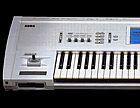| |
| INTRODUCTION |
 |
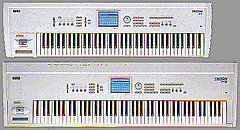 |
Korg
Triton is a music workstation with advanced synthesis and sampling
functions.
Initially available in 3 models, depending on the keyboard size,
the Triton series included:
- Triton, featuring 61 light keys
- Triton Pro, featuring 76 light keys
- Triton ProX, featuring 88 weighted-action keys.
These 3 models share the same expansion capabilities (with optional
boards and memory expansions), so that the workstation configuraztion
can be easily adapted to the user needs. Triton is therefore a very
versatile instrument, that can be useful in both studio and live
applications.
Some years after, a new Triton series was introduced including Triton
LE and Triton Studio models.
 Options Options
 Triton
LE, Triton Studio, Triton Rack Triton
LE, Triton Studio, Triton Rack
 Technical
Details Technical
Details
|
|
| MAIN
FEATURES |
 |
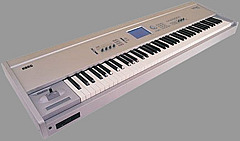 |
Triton
features a very detailed, highly professional sound character. Despite
its complexity, the operation is quite intuitive and the user interface
very straight and practical. This is largely due to the huge graphic
backlit Touch Screen display, that makes the programming process easy
and fast even without using an external computer editor.
Patch selection is aided by a powerful database function, very useful
in a machine that can potentially handle thousands of sounds.
The Triton sonic palette is largely expanded thanks to its sampling
functions. The analog audio input can also be used to process in real-time
external signals using the powerful internal FX processors.
The synthesis channel features a resonant filters section, together
with versatile FX processors that can be fully controlled via MIDI
for a deeper expressive performance. An optional expansion board (EXB-MOSS)
adds physical modeling synthesis capabilities.
Triton features also some functions such as the sequencer and the
arpeggiators that reprtesent a great aid in creating complux musical
structures in real-time.
The operating system can be upgraded using the internal Floppy Disk,
so that the system can be easily mantained up-to-date. |
|
|
| |
Polyphony
and multi-timbral operation.
Triton polyphony consists of 62 notes; 6 additional notes ae available
with the SXB-MOSS expansion board installed.
The EXB-MOSS board, based on physical modeling synthesis, is polyphonic
and can work in multitimbral mode.
Up to 16 independent parts can be freely assigned to the 16 available
MIDI channels. |
|
|
| |
Advanced
internal architecture.
The sound data structure follows the traditional Korg style, being
based on 4 levels called Sample (PCM), Program, Combination and Sequencer.
The single PCM Samples are grouped in Multisounds, where each Sample
is assigned to a certain keyboard range.
Percussive samples are organized into programmable Drum Kits, where
each sound can have its independent parameter settings.
Programs are formed by 2 voices, called "Oscillator". Each Oscillator
can include 2 velocity-switched Multisounds.
Combinations include up to 8 Programs, freely configurable and assignable
to the various MIDI channels. When in Sequencer mode, Progrems are
addressed using the Song structure, that can manage 16 Programs (or
2 Combinations).
While Combinations are ideal for live performance, Sequencer mode
can be used in conjunction with the internal Sequencer or to use the
Triton as a multitimbral Expander.
The configuration of the FX processors and the 2 arpeggiators can
be managed in Program, Combination and Sequencer mode in an independent
way. |
|
|
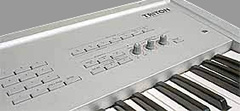 |
Preset.
Triton features a wide timbric range thanks to a very large memory.
Sounds are divided into 7 banks, each containing 128 Program, plus
10 Variation banks for the GM sounds and 4 banks of 128 Combinations.
These banks can contain:
- 768 Programs and 512 Combinations
- 128 GM Level 2 Presets + Drum Set
-
1280 GM Preset Variations + Drum Set Variations.
Sound banks are organized differently according to the selected
operating mode.
Program mode:
- A, B, C, D: used to store the PCM-based patches.
-
E: normally used for the sampler section, can also contain normal
PCM-based patches.
- F: is dedicated to the EXB-MOSS expansion board.
- G: contains the General MIDI sounds and Variations.
Combination mode:
- A, B, C, D: fully editable banks.
|
|
|
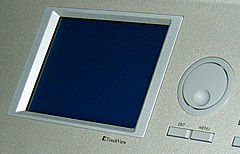 |
Editing.
Editing
is based on 2 different levels: RealTime and Edit.
Various real-time controls found on the front panel and shown in
the display give access to the main psound parameters without entering
Edit mode, that allows to reach the most advanced parameters.
Even if the system is very complex, the editing process is quite
fast thanks to the various menus showing the available functions.
|
|
|
| |
Analog
input.
The
stereo analog input used for sampling is provided with a sensitivity
control that simplify the connection with different signal sources.
The input signal can be processed in real-timee using the integrated
FX processors.
|
|
|
| |
Serial
interface (To Host).
This
port is used to directly connect the Triton to a computer (Mac or
PC) without using a MIDI interface and providing a higher communiration
rate.
Korg produces an optional Kit (Mac an PC versions are available)
consisting of a connection cable and the software needed to use
this interface.
|
|
|
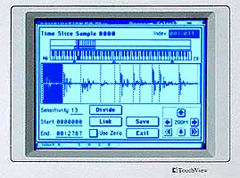 |
PCM format compatibility.
In
addition to the sampling functions, Triton can import PCM samples
coming from third-party libraries. Supported formats include Korg,
Akai S1000 and S3000, WAV and AIFF.
Samples can be loaded from the internal Floppy Disk or, if the optional
SCSI interface is installed, using external Hard Disks or CD-ROM
drives.
The internal RAM memory can be expanded up to 64 Mb, that correspond
to nearly 12 minutes of mono sampling time.
|
|
|
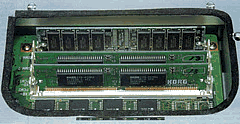 |
Optional
PCM boards.
The
Triton sonic palette can be extended by installing PCM boards that
contain additional sound libraries specifically made by Korg.
Each package consists of a PCM board and a Floppy Disk containing
the Programs that use the new samples.
|
|
|
| |
FX
processors.
Triton
features 3 multiple digital FX procesors that can generate 5 freely
configurable Insert FX (Stereo-In/Stereo-Out) and 2 Master FX (Mono-In/Stereo-Out).
Master effects features 2 auxiliary sends, that can also be used
after the Insert effects.
Each Program, Combination or Song can have its own effect set and
control in real-time the effect parameters.
|
|
|
| |
GM
Compatibility.
Triton
is fully compatible with the General MIDI Level-2 standard, giving
access to the large number of GM-based Songs available.
|
|
|
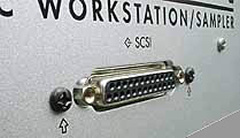 |
SCSI
interface.
Installing
this optional the Triton can be connected to external SCSI devices
such as fixed or removable Hard Disks, CD-ROM drives, etc.
The Hard Disks are formatted in DOS mode, and can be accessed form
a PC or Mac computer for data management and CD-ROM backup functions.
|
|
|
|
|
Master
Keyboard functions.
Basic Master Keyboard functions are available in Combination and
Sequencer mode.
|
|
|
|
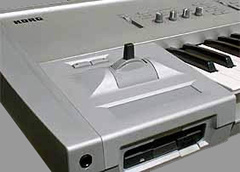
|
Real-time
MIDI controllers.
Triton
features various real-time performance controllers:
- Touch Screen Display;
- Joystick;
- Ribbon Controller;
- 2 On/Off (or temporary) switches;
- 4 rotating knobs;
- 1 Data Entry slide cursor;
- 3 external pedals (2 freely assignable).
|
|
|
| |
Arpeggiators.
Two
fully programmable polyphonic arpeggiators can generate rhythmic
pattern or complex musical structures.
The RPPR (Real Time Pattern Play/Recorder) function allows to trigger
these patterns from a sequencer track or from a key, creating powerful
real-time interaction possibilities.
|
| |
|
CONCLUSIONS
|
 |
|
|
Triton
is a very complete WorkStation, that is able to support complete high-quality
music productions without using external computer or sound generators,
thanks to its high sonic quality, to the real-time performance control
functions, to the integrated sequencer and to the powerful programmable
arpeggiators. |



